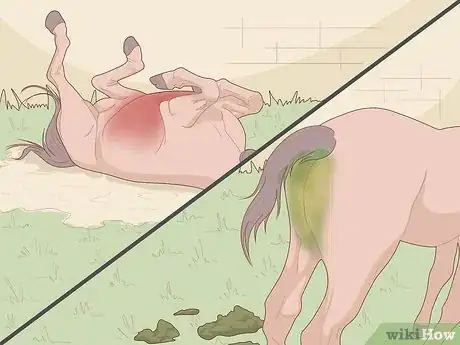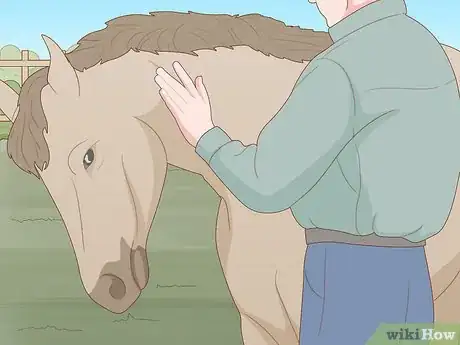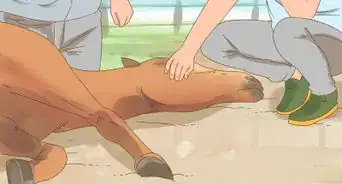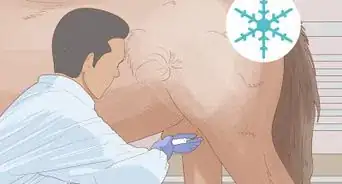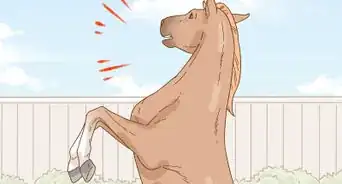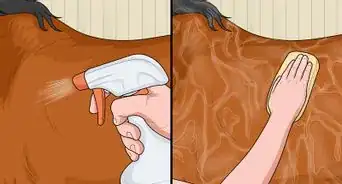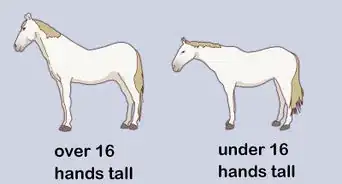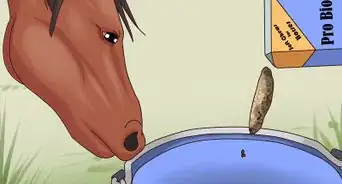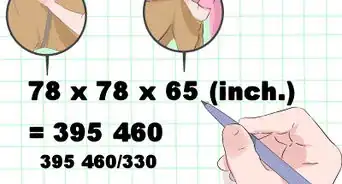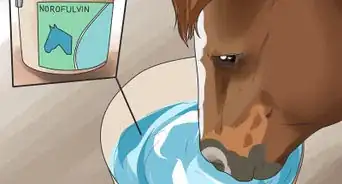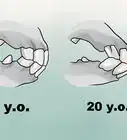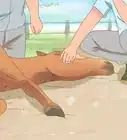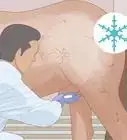This article was co-authored by Pippa Elliott, MRCVS. Dr. Elliott, BVMS, MRCVS is a veterinarian with over 30 years of experience in veterinary surgery and companion animal practice. She graduated from the University of Glasgow in 1987 with a degree in veterinary medicine and surgery. She has worked at the same animal clinic in her hometown for over 20 years.
wikiHow marks an article as reader-approved once it receives enough positive feedback. In this case, 88% of readers who voted found the article helpful, earning it our reader-approved status.
This article has been viewed 111,075 times.
Many novice riders, and even some professionals, sometimes need help assessing if their horse is sick or injured. Knowing the physical and behavioral symptoms of illness or injury will help you determine whether your horse needs veterinary attention. Note, however, that if you ever have concerns about the well-being of your horse, you should immediately contact your veterinarian.
Steps
Assessing Physical Symptoms
-
1Check your horse's basic diagnostics. This means your horse's pulse/heart rate, respiratory rate, and temperature.
- Pulse - The normal heart rate for a horse is 25-42 beats per minute. To check the horse's heart rate, place your palm on the horse's chest just behind the left elbow and feel for the bump-bump-bump of the heart beat. Count how many beats there are in a minute; this is the heart rate. It can also be useful to routinely calculate your horse's resting heart rate. Knowing what your horse's regular or normal rate is will make it easier for you identify abnormalities in the heart rate. Note that a consistently racing heart rate when the horse is resting (i.e., one that is higher than the usual upper limit of 42 beats/minute) can be a sign of heart disease or infection. If you discover your horse has a racing heart even when she's resting, get her checked out by a vet.[1]
- Respiratory rate - The normal respiratory rate for horses is 10-24 breaths per minute. To check your horse's respiratory rate, stand back and watch her chest movements. One in-out movement of the chest counts as one breath. Count how many times this happens in one minute. It's best to do this check when your horse is resting so that this will be an indication of her normal respiratory rate. Make sure to wait to check her respiratory rate until at least half an hour after exercise. A raised respiratory rate during resting can be indicative of many different problems, including infection, allergy, fluid in the lungs, heart disease, and possibly cancer. All of these require veterinary attention.[2]
- Temperature - The normal equine temperature is 98-101 Fahrenheit or 37.2 - 38.3 Celsius. A temperature above 38.3 Celsius is considered raised. You should monitor your horse's temperature if it reaches 38.3 degrees.[3] If the temperature is between 38.3-38.8, then take your horse's temperature every couple of hours until the fever breaks.[4] If the temperature rises above 38.8, call your vet. Such a high temperature is a sign of infection or severe inflammation.[5]
-
2Examine your horse's eyes, nose, and mouth. Look for any unusual and sticky discharge, such as yellow or green pus. This may be an indication that your horse is sick. If you see any blood, contact the vet immediately.[6]
- When checking the eyes, look to see if the eyes appear sunken in or the eye area appears hollowed out a bit. This could be a sign of Horner's syndrome, a disease relating to the nervous system that is common in many animals. Check also to see if the eyelids look droopy or if the horse's third eyelid (usually in the corner of each eye) is protruding upwards and moving over the eye; these are often symptoms of an infection or additional symptoms of Horner's syndrome. In addition, if the eyes can't fully open, you should consult a vet.[7]
Advertisement -
3Examine your horse's coat and skin. A dull coat is a sign that the horse is either in poor condition, suffering from a lack of nutrition or not grooming herself properly. If this is the only symptom, it is likely not an emergency, but you would do well to mention it to the vet the next time you see him. However, if this is one of several symptoms that you notice, call the vet directly.[8]
- You can also test the elasticity of your horse's skin to check whether she or he is dehydrated. Gently lift the skin covering your horse's shoulders. When you let go, the skin should instantly pop back down; if you can watch the skin fall back droopily, then the horse is dehydrated. Horses can become dehydrated if they're not drinking enough, or are losing more fluid than they're taking in. Another way to check for dehydration is to examine your horse's mouth and feel how moist the membranes lining the lips and gums are. They should feel moist and slippery; if they feel dry and tacky, this means that the horse is dehydrated. If the horse is dehydrated, make sure she has access to water and call the veterinarian.[9]
-
4Evaluate your horse's bowel movements. Constipation or diarrhea are both signs that something is not right with your horse. You may see your horse straining to pass feces but nothing comes out (constipation); alternatively, she may pass feces that are more liquid than usual (diarrhea). In both cases, you should consult your vet.[10]
- If you notice any blood in your horse's stool, then the problem is urgent.
-
5Check your horse's urine. Concentrated urine can appear a dark color, but so does urine that contains blood or the breakdown products of blood. If the urine consistently appears unusually dark, you should consult your vet.
- If you suspect that dehydration is the cause of overly concentrated, dark-looking urine, remember that you can check the elasticity of your horse's skin to determine whether dehydration is at work.
- Where possible, collect a urine sample for your veterinarian to analyze.
-
6Check the color of your horse's gums. Most horses' gums are pink or lightly pigmented, just like human gums. If you lift your horse's lip and the gums appear very pale, abnormally dark or muddy looking, or bright red, then contact the vet immediately.
-
7Check to see whether your horse is sweating more than usual. A horse should not sweat profusely when she is resting, unless it's extremely hot outside. Sweating is often a sign that the horse is running a fever, is fearful, or is in pain.
- Note that horses lose electrolytes, such as sodium and chloride, in their sweat. This means that they become dehydrated from sweating profusely. It is therefore important to call the veterinarian if the horse is sweating heavily and yet refusing food and water.[11]
-
8Assess whether your horse is standing oddly. If your horse looks like she is standing in an awkward manner, this is an indication that the horse is experiencing pain somewhere in her body.
- For example, if she stands rocked backwards, with her back legs placed beneath her belly and her front legs stuck out in front, this is usually a sign that she wants to take her weight off the front end because of sore feet. Sore feet can be a symptom of laminitis.
- In addition, if your horse stretches herself out when standing (i.e., her front feet are very far out and her hind feet are too far behind), this may be an attempt to relieve abdominal cramps or gut discomfort. If ever you suspect gut pain, contact your vet for guidance.
-
9Watch your horse move around. Check to see if your horse is moving stiffly or with an altered gait, or way of walking. If she is moving with stiffness or tension, she may be in pain or suffering from inflamed muscles or joints. You'll want to observe this over some time. After all, your horse may just be stiff after vigorous exercise and just needs a gentle walk to regain her full range of movement.
- If, however, after some gentle walking, your horse becomes stiffer still and is reluctant to move, then call a veterinarian.
Assessing Behavioral Symptoms
-
1Consider whether your horse has exhibited dullness. Dullness means that the horse does not respond in her usual manner, such as greeting you with a whinny, or banging the stable door for feed.
- Dullness is often accompanied by a change in body language. She may start, for example, holding her head low and her ears may fail to twitch and not respond to surrounding sounds.[12]
-
2Determine whether your horse exhibits signs of restlessness. Does she pace more than she usually does or exhibit a hard time settling down? A horse that is restless and doesn't relax in her stable in the usual way should be monitored closely. If the horse starts to throw herself to the ground, or lies downs and rises repeatedly, or kicks at her own belly, you should call the vet. These can all be signs of colic and should not be dismissed.
-
3Assess whether your horse is eating as usual. Horses are grazers, which means they eat little but eat very often. Research indicates that not eating even for 6 hours may predispose a horse to stomach ulcers, which highlights just how important regular eating patterns are to their well-being. If you notice your horse refusing food or water, or that her regular feed schedule is off, contact your vet.[13]
- Watch your horse eat and check to see whether she is dropping a lot of feed while she eats. A horse's diet is high in fibre and necessitates a lot of chewing and grinding prior to swallowing. The large molar teeth towards the back of a horse's mouth are the equine equivalent of mill-stones. If your horse has a toothache, or the teeth have worn down unevenly and there is a sharp cusp digging into the cheek or tongue, then the horse will drop food out of her mouth. Sometimes this food is partially chewed and rolled up into balls, which then drop out of the mouth. This is known as quidding. Extremely messy eating and quidding are symptoms of dental discomfort and should be taken as signs to call the vet.[14]
- The same goes for a horse that chews but can't swallow. These horses often appear hungry, chew their food, but then lower their heads, at which point the food usually falls out of their mouths. This can be caused by discomfort at the back of the throat, such as an ulcer or thorn between the teeth, the lodging of food in the esophagus (also known as choking), or infections like botulism.[15]
References
- ↑ Essential Equine Studies. Julie Brega. Publisher: J A Allen
- ↑ Essential Equine Studies. Julie Brega. Publisher: J A Allen
- ↑ Essential Equine Studies. Julie Brega. Publisher: J A Allen
- ↑ Essential Equine Studies. Julie Brega. Publisher: J A Allen
- ↑ Essential Equine Studies. Julie Brega. Publisher: J A Allen
- ↑ Essential Horse Health: Kieran O'Brien. Publisher: David & Charles
- ↑ http://www.aces.edu/pubs/docs/A/ANR-0589/index2.tmpl
- ↑ Essential Horse Health: Kieran O'Brien. Publisher: David & Charles
- ↑ Essential Horse Health: Kieran O'Brien. Publisher: David & Charles
- ↑ Essential Horse Health: Kieran O'Brien. Publisher: David & Charles
- ↑ Essential Horse Health: Kieran O'Brien. Publisher: David & Charles
- ↑ Essential Horse Health: Kieran O'Brien. Publisher: David & Charles
- ↑ Essential Horse Health: Kieran O'Brien. Publisher: David & Charles
- ↑ Principles of Equine Dentistry. David O'Klugh. Publisher: CRC Press
- ↑ Principles of Equine Dentistry. David O'Klugh. Publisher: CRC Press
About This Article
If you think your horse is sick, first take its vitals, like its pulse and temperature, and examine its eyes, ears, and mouth for any discharge, which is a sign that something's not right. Then look for common symptoms of sickness, like a dull coat, dark urine, or excessive sweating. Pay attention to how your horse is acting, too. Notice if it’s acting overly restless, which could mean your horse has colic, or if it's eating different amounts than usual, which could be due to ulcers. To learn more about determining whether or not your horse is sick, including when to take it to the vet, read on.



